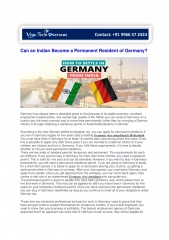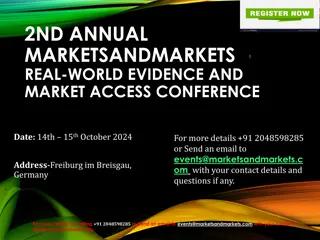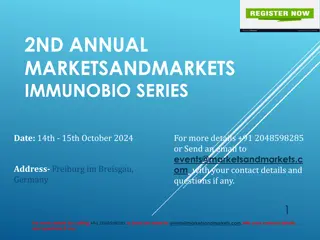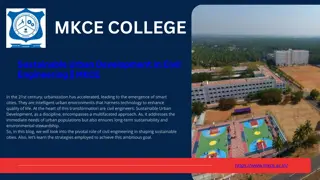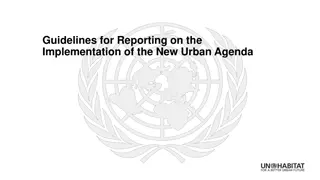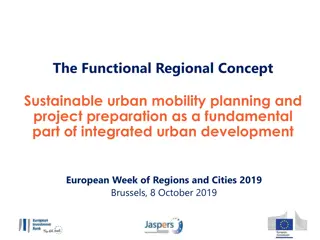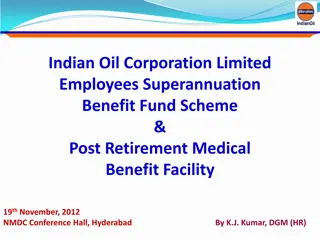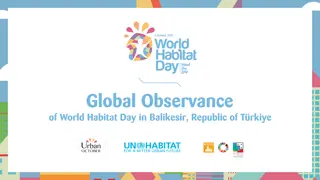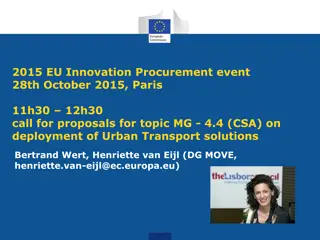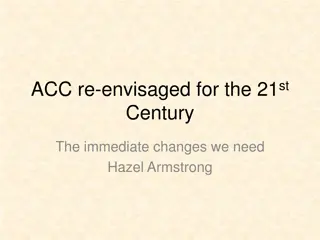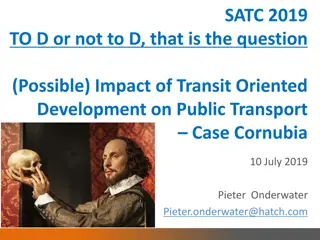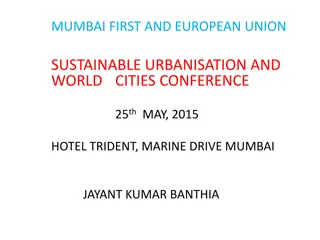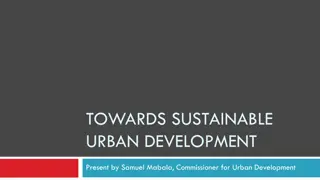Sustainable Urban Transport Scheme in Freiburg, Germany
Freiburg, Germany, has effectively implemented an integrated urban transport plan, including a 30 km tram network and extensive cycle lanes, to reduce traffic congestion, pollution, and fossil fuel use. With affordable tram fares and seamless connections to bus routes, the city has seen a significant shift from car use to public transport, promoting sustainability and improving both health and environmental outcomes.
Download Presentation

Please find below an Image/Link to download the presentation.
The content on the website is provided AS IS for your information and personal use only. It may not be sold, licensed, or shared on other websites without obtaining consent from the author.If you encounter any issues during the download, it is possible that the publisher has removed the file from their server.
You are allowed to download the files provided on this website for personal or commercial use, subject to the condition that they are used lawfully. All files are the property of their respective owners.
The content on the website is provided AS IS for your information and personal use only. It may not be sold, licensed, or shared on other websites without obtaining consent from the author.
E N D
Presentation Transcript
Paper 2 Living with the Human Environment Section A Urban Issues and Challenges (urban change, urban growth and sustainable urban development) NEE City Case Study Rio de Janeiro Sustainable City - Freiburg HIC City - Portsmouth
Urban Issues and Challenges? Decide on the PE/PEE/PEEL paragraphs, their type and number Decide on the points you want to make based on what you know Apply BUM to the question Begin to write your answer Exam question: Evaluate the effectiveness of (an) urban transport scheme(s) you have studied (9 marks + 3 SPaG) What is the command word to be boxed? Evaluate What are the important words and keywords to be underlined? effectiveness, urban transport scheme(s), studied Based on the marks, how many and what sort of paragraphs should you write? 3 x PEEL paragraphs
Urban Issues and Challenges? Decide on the PE/PEE/PEEL paragraphs, their type and number Decide on the points you want to make based on what you know Apply BUM to the question Begin to write your answer Exam question: Evaluate the effectiveness of (an) urban transport scheme(s) you have studied (9 marks + 3 SPaG) What key words could you include? sustainable, traffic congestion, traffic pollution What cheeky facts could you include? 400 km of cycle paths; 30 km of tram lines; bike and ride at railway stations; 20,000 parking space in one area What connectives should you include? On the one hand on the other hand As a result
Exam question: Evaluate the effectiveness of (an) urban transport scheme(s) you have studied (9 marks + 3 SPaG) P: Freiburg, SW Germany, has cut traffic congestion through in which all transport options are linked together making them very efficient. an integrated transport plan the 30 km long tram network. E: The most important form of transport in the city is E: This has led to a huge reduction in the use of cars and the growth of the use of trams, especially as fares are low and the tram connects with the bus routes. very effective at reducing traffic congestion, pollution and fossil fuel use. L: Therefore, the integrated transport scheme has been cycle lanes, bike P: In addition, personal transport has been encouraged in the form of parks and bike and ride at railway stations. E: There are many kilometres of cycle lanes, E: This is socially and environmentally sustainable because health as well as not polluting the environment. 400 km to be exact. cycling improves people s L: The cycle scheme is highly effective because using a car. there are stick ones (negative approaches) too. high parking space fees, such as 20,000 in one area! discourage people from owning and using a car so that they use public transport, but only rich people can afford to have a car. many people can get around without P: However, in addition to these carrot (positive approaches) E: These include E: These aim to been highly effective at L: Overall, the urban transport schemes used in Freiburg have reducing unsustainable transport use.
Urban Issues and Challenges? Decide on the PE/PEE/PEEL paragraphs, their type and number Decide on the points you want to make based on what you know Apply BUM to the question Begin to write your answer Exam question: Evaluate the effectiveness of (an) urban transport scheme(s) you have studied (9 marks + 3 SPaG) What is the command word to be boxed? Evaluate What are the important words and keywords to be underlined? effectiveness, urban transport scheme(s), studied Based on the marks, how many and what sort of paragraphs should you write? 3 x PEEL paragraphs
Urban Issues and Challenges Decide on the PE/PEE/PEEL paragraphs, their type and number Decide on the points you want to make based on what you know Apply BUM to the question Begin to write your answer Exam question: Evaluate the effectiveness of (an) urban transport scheme(s) you have studied (9 marks + 3 SPaG) What key words could you include? sustainable, traffic congestion, traffic pollution What cheeky facts could you include? London Congestion Charge, 11.50, 10% fewer cars Ultra-Low Emission Zone, 16.50 What connectives should you include? On the one hand on the other hand As a result
Exam question: Evaluate the effectiveness of (an) urban transport scheme(s) you have studied (9 marks + 3 SPaG) P: London is trying to reduce its traffic congestion through E: This charges motorists E: This has led to a reduction of ten per cent in the number of vehicles entering the centre, although taxis, buses, emergency vehicles and low-emission cars are exempt. there are fewer cars causing congestion, but not a huge number, although there would be many more otherwise. Ultra-Low Emission Zone in the city centre. 15.00 to drive into the centre of the city. fewer cars causing congestion and greater use of low-emission cars, walking, cycling and public transport. combined with the Congestion Charge, it could lead to a significant reduction in cars, congestion and pollution. the only one way to discourage car use and they punish people for driving. improved cycle lanes, buses and Underground. encourage people to use public transport and healthier ways of getting around. congestion a mixture of schemes to encourage people out of their cars is better. the Congestion Charge. 11.50 to drive into the centre of the city. L: The scheme has been partly effective because P: In addition, London has introduced this year the E: This charges motorists a further E: This scheme will hopefully lead to L: The scheme could be effective because P: Schemes that charge motorists to enter the city centre are E: Other strategies London uses are E: These aim to effective, but to reduce traffic L: Overall, the Congestion Charge and ULEZ are
Paper 2 Living with the Human Environment Section A The Changing Economic World (development, aid, closing the gap tourism (Jamaica) globalisation and quality of life) NEE Case Study Nigeria (work booklet) HIC City UK (work booklet)
To what extent is the development gap a result of Physical factors [6 Marks] Physical Human Weather and Climate Drought Political Influences Government Stability; Corruption Natural Hazards Trade lack of; world trade not being fair If the country is landlocked Historical reasons - colonialism A lack of natural resources to exploit Debt
On one hand - Physical Factors How can weather and climate, in particular drought, affect the country s ability to develop? Extreme drought lack of rainfall affect farmers being able to grow crops effectively this will result in a poor crop yield won t have enough crops to sell and earn an income won t be able to afford to send children to school they won t be educated further hindering their opportunity to get a job in the future impacting on the country s development . Or if the farmer is a commercial farmer and does not enough crops to sell - this will impact on the country s overall GDP. But on the other hand Human factors How can trade, affect the country s ability to develop? World trade dominated by HICs/NEEs/TNCs they want the lowest prices for goods so they can achieve huge profits LICs forced to sell raw materials at a low price less money for the country affects development of country as it is unable to grow plus gap gets bigger as HICs get richer due to profits made. Overall is it just physical factors? No many factors influencing the development gap, not just physical factors such as . but human factors too, such as ..also play a significant part.
On one hand, physical factors such as weather and climate can influence a countrys ability to develop. Extreme weather such as drought can result in a country being unable to grow crops efficiently. Poor crop yields mean that farmers are unable to earn enough money which means that they don t earn enough money to send their children to school. As a consequence their children will not be able to get well paid jobs in the future hindering the country s development further. However on the other hand, human factors such as trade can also affect a country s ability to develop. Trade across the world is dominated by HICs and TNCs. These countries and companies want to buy raw materials for as little as possible so they can make the biggest profits. As a result LICs are forced to sell their produce for very low prices which means that the people in the LICs earn less resulting in less money being earnt by the government by taxes. Not only does this affect the ability of the LICs to develop but it also increase the development gap further as the HICs are able to make greater profits and as a consequence develop further. Overall, the development gap is hindered by a combination of many factors. Some of those factors are physical factors such as weather and climate, natural hazards, a lack of raw materials or the country being landlocked. There are also a number of human factors too influencing development such as trade, the political status of the country, historical reasons such as colonialism and how much debt the country has.
Paper 2 Living with the Human Environment Section A The Challenge of Resource Management (global resource management, resources in the UK, *food) Example Sustainable Method to increase food supplies Rice Fish Farming, Jamalpur, Bangladesh (No 9 mark question in this section)
Example???? Sustainable???? What does that mean? How is it increasing sustainable supplies of food?
Example???? Rice Fish Farming, Jamalpur, Bangladesh Sustainable???? meeting the needs of current generations without compromising future generations How is it increasing sustainable supplies of food? 1. Explain how it works what is the strategy? 2. How is it sustainable? a. Rice yields increase farmers can sell the extra rice grown and increase income this is then reinvested back into their farms used to buy more land increase yields further - economically sustainable b. Local farmers educated on how to rice-fish farm they teach other farmers passed on through generations local farmers work together - socially sustainable. c. Environmentally sustainable minimal impact on the environment no chemicals harming the environment damaging ecosystems
I have studied rice-fish farming in Jamalpur, Bangladesh. It is an economically, socially and environmentally sustainable method of increasing food supplies and it meets the needs of current generations, without compromising the needs of future generations. The rice is grown in rice paddies and in the water surrounding the rice plants are fish. The two are mutually beneficial for each other as the fish eat the pests and insects on the plants, and provide nutrition for the plants to grow. The plants provide a good environment for the fish to swim in as they oxygenate the water. As a result of the fertilised water the Rice yields have increased. There is enough food to feed families both with the rice and the fish and farmers can sell the extra rice grown and increase their income. This money is then reinvested back into their farms and used to buy more land, increasing yields further. This is economically sustainable. Not only this, but local farmers are educated on how to rice-fish farm. As a result, hey teach other farmers and this is passed on through generations. Local farmers work together making rice fish farming socially sustainable. Finally, it also environmentally sustainable. RFF has minimal impact on the environment as no chemicals are used harming the environment and therefore damaging ecosystems.


